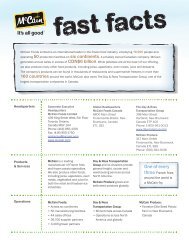From the Ground Up - McCain Foods Limited
From the Ground Up - McCain Foods Limited
From the Ground Up - McCain Foods Limited
Create successful ePaper yourself
Turn your PDF publications into a flip-book with our unique Google optimized e-Paper software.
LEFt: Randy Myles (left)<br />
vice-president of finance and<br />
CFO, <strong>McCain</strong> <strong>Foods</strong> USA, with<br />
Randy Wieland, senior vicepresident,<br />
food service sales,<br />
<strong>McCain</strong> <strong>Foods</strong> USA.<br />
RIGht: Research and<br />
development at <strong>the</strong> O<strong>the</strong>llo,<br />
Washington, plant. Bill Skorick<br />
and Sharon Nelson are on <strong>the</strong><br />
left; Liz Jensen, research and<br />
development manager, is on<br />
<strong>the</strong> right.<br />
great fanfare on December 1 when it came onto our system,” says Van Schaayk. But<br />
<strong>the</strong> excitement quickly turned to disappointment when <strong>the</strong> service levels of <strong>the</strong> former<br />
Ore-Ida division plummeted overnight. “It was almost a catastrophe. There were<br />
so many things that had not been understood and anticipated as large issues. People<br />
were just overwhelmed.”<br />
The case fill rate fell to <strong>the</strong> mid-seventies, meaning that if a customer ordered one<br />
hundred cases of product, only about seventy-five got delivered – an unacceptably poor<br />
level of service. This was because of several problems, including information technology<br />
issues, organization of <strong>the</strong> sales force, production planning, and inadequate forecasting.<br />
The Ore-Ida acquisition forced <strong>McCain</strong> to upgrade its entire business system<br />
to a different standard. “It made us get better in all areas of <strong>the</strong> business,” says<br />
Van Schaayk. Before <strong>the</strong> acquisition, <strong>McCain</strong> was <strong>the</strong> fifth-largest potato company in<br />
<strong>the</strong> United States, points out David Sanchez, who became vice-president for integration<br />
in 1997 to supervise <strong>the</strong> integration of Ore-Ida. “Our systems and processes were<br />
extremely weak. It was an around-<strong>the</strong>-clock fight for four to five months just to do<br />
<strong>the</strong> basics of shipping product and collecting money. In <strong>the</strong> meantime, <strong>the</strong> factories<br />
got completely out of control, and we ended up with three hundred million pounds<br />
of inventory, most of it stuff we did not need.” For example, <strong>McCain</strong> had a two-year<br />
supply of one product that had a shelf life of only eighteen months.<br />
Integrating systems is hard, but integrating people and company cultures is even<br />
harder. The Ore-Ida organization, says Van Schaayk, “had a culture closer to what<br />
you would expect from a corporate food company like Heinz – it had deeper training,<br />
it was well organized, it had high expectations for personal growth, and it was dealing<br />
with a greater number of premium customers. It was a real scramble to get in front of<br />
that sales force, to begin to paint a picture of what <strong>McCain</strong> could be with its help, to<br />
begin to try to energize that group and get it excited about helping build <strong>McCain</strong> as a<br />
premier food service business in <strong>the</strong> United States.”<br />
Randy Wieland, who as of 2007 was senior vice-president of food service sales<br />
for <strong>McCain</strong> USA, is a U.S. food industry veteran who joined <strong>McCain</strong> in 1991. He met<br />
with each Ore-Ida salesperson individually. His goal was to inform <strong>the</strong> sales force of<br />
<strong>McCain</strong>’s global scale, explain how <strong>the</strong> company operated, and have it embrace <strong>the</strong><br />
challenge of building <strong>McCain</strong> into a great U.S. food company.<br />
To help <strong>the</strong> new arrivals to <strong>the</strong> company better grasp what <strong>McCain</strong> was all about,<br />
several of <strong>the</strong> key Ore-Ida people were brought to Florenceville for a sales planning<br />
meeting in <strong>the</strong> boardroom. Florenceville is a rural village, but <strong>the</strong> illuminated map<br />
on <strong>the</strong> wall of <strong>the</strong> boardroom impressively displays a <strong>McCain</strong> world that spans <strong>the</strong><br />
globe. Harrison <strong>McCain</strong> spoke passionately to <strong>the</strong> group about <strong>the</strong> company and its<br />
ambitious plans for <strong>the</strong> U.S. operations. The point of <strong>the</strong> exercise was to convince<br />
<strong>the</strong> Ore-Ida people that <strong>the</strong>y had joined not a small U.S. frozen food company but a<br />
major international frozen food company. “I think <strong>the</strong> people at Ore-Ida were surprised<br />
at <strong>the</strong> roll-up-your-sleeves attitude at <strong>McCain</strong> and <strong>the</strong> involvement of senior<br />
management in all aspects of <strong>the</strong> business,” says Randy Myles, vice-president and<br />
chief financial officer of <strong>McCain</strong> USA.<br />
Most of <strong>the</strong> people who came on that trip to Florenceville were still working for<br />
<strong>McCain</strong> USA in 2007, several of <strong>the</strong>m in high-level positions in <strong>the</strong> food service sales<br />
force. The larger scale that came with <strong>the</strong> Ore-Ida acquisition had ano<strong>the</strong>r important<br />
impact on <strong>McCain</strong> USA. It meant that <strong>the</strong> U.S. company could justify recruiting top<br />
personnel from o<strong>the</strong>r parts of <strong>the</strong> global <strong>McCain</strong> organization.<br />
178 f rom <strong>the</strong> <strong>Ground</strong> up<br />
south of <strong>the</strong> border 179<br />
toP LEFt: Rice Lake,<br />
Wisconsin, appetizer plant:<br />
Theresa Schultz and Sherri<br />
Becker position onions for<br />
cutting.<br />
toP RIGht: Amy<br />
Christensen and Cindy Payne<br />
check product in <strong>the</strong> qualitycontrol<br />
lab at <strong>the</strong> Grand<br />
Island, Nebraska, appetizer<br />
plant.<br />
bottoM: Poppers – stuffed<br />
and breaded jalapeño<br />
peppers – are a popular<br />
Anchor finger food.






